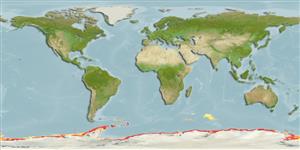Staurotheca antarctica Hartlaub, 1904
| Native range | All suitable habitat | Point map | Year 2050 |

|
| This map was computer-generated and has not yet been reviewed. |
| Staurotheca antarctica AquaMaps Data sources: GBIF OBIS |
Mandar um arquivo com seu (sua) Fotos
Imagem do Google |
No photo available for this species.No drawings available for Sertulariidae.
Imagem do Google |
No photo available for this species.
Classification / Names Common names | Synonyms | CoL | ITIS | WoRMS
| Leptothecata | Sertulariidae
Environment: milieu / climate zone / depth range / distribution range Ecologia
; intervalo de profundidade 55 - 661 m (Ref. 7414). Polar
Distribuição Países | Áreas FAO | Ecossistemas | Ocorrências | Introduções
Circum-Antarctic.
Length at first maturity / Tamanho / Peso / Idade
Maturity: Lm ? range ? - ? cm Max length : 3.0 cm WD macho/indeterminado; (Ref. 7414)
Descrição suscinta Morfologia
Colonies consisting of a mass of stems and branches up to 3 cm in diameter. Branching frequent and irregular. Branches numerous and provided with many anastomoses, giving the colony a compact appearance.
Depth and length based on occurrence record; to be replaced with better reference.
Life cycle and mating behavior Maturidade | Reprodução | Desova | Ovos | Fecundidade | Larvas
Members of the order Leptothecata include L-form hydroids. Life cycle: The zygote develops into planula and later into polyp then into free-swimming medusa.
Referência principal
Referências | Coordenador | Colaboradores
Peña Cantero, A.L. and W. Vervoort. 2003. (Ref. 7414)
Status na Lista Vermelha da IUCN (Ref. 130435)
Status no CITES (Ref. 108899)
Not Evaluated
CMS (Ref. 116361)
Not Evaluated
Perigo para os humanos
Harmless
Uso pelos humanos
| FishSource |
Ferramentas
Mais informação
Fontes da internet
BHL | BOLD Systems | CISTI | DiscoverLife | FAO(Publication : search) | Fishipedia | GenBank (genoma, nucleotídeo) | GloBI | Gomexsi | Google Books | Google Scholar | Google | PubMed | Árvore da vida | Wikipedia (Ir para, procura) | Registro zoológico
Estimates based on models
Preferred temperature
(Ref. 115969): -1.8 - 0.8, mean -1 (based on 441 cells).


